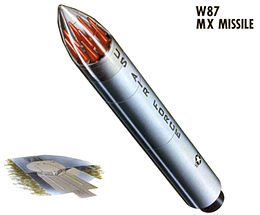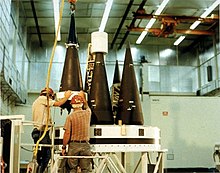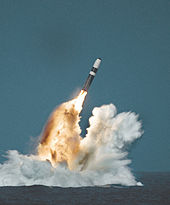
Back مركبة إعادة الدخول المتعددة المستهدفة بشكل مستقل Arabic MIRV Azerbaijani Multiple independently targetable reentry vehicle German Vehículo de reentrada múltiple e independiente Spanish هدفگیری مستقل چندگانه Persian MIRV Finnish Mirvage French Feithicil ilathiontrála dírithe go neamhspleách Irish טיל מרובה ראשי נפץ HE MIRV Hungarian
This article needs additional citations for verification. (June 2014) |




A multiple independently targetable reentry vehicle (MIRV) is an exoatmospheric ballistic missile payload containing several warheads, each capable of being aimed to hit a different target. The concept is almost invariably associated with intercontinental ballistic missiles carrying thermonuclear warheads, even if not strictly being limited to them. An intermediate case is the multiple reentry vehicle (MRV) missile which carries several warheads which are dispersed but not individually aimed. All nuclear-weapon states except Pakistan[a] and North Korea are currently confirmed to have deployed MIRV missile systems. Israel is suspected to possess or be in the process of developing MIRVs.[4]
The first true MIRV design was the Minuteman III, first successfully tested in 1968 and introduced into actual use in 1970.[5][6][7] The Minuteman III held three smaller W62 warheads, with yields of about 170 kilotons of TNT (710 TJ) each in place of the single 1.2 megatons of TNT (5.0 PJ) W56 used on the Minuteman II.[8] From 1970 to 1975, the United States would remove approximately 550 earlier versions of the Minuteman ICBM in the Strategic Air Command's (SAC) arsenal and replace them with the new Minuteman IIIs outfitted with a MIRV payload, increasing their overall effectiveness.[6] As of 2017 the Minuteman III missile was converted to a single reentry vehicle system.[9][10] The smaller power of the warheads used (W62, W78 and W87) was offset by increasing the accuracy of the system, allowing it to attack the same hard targets as the larger, less accurate, W56.[8][11] The MMIII was introduced specifically to address the Soviet construction of an anti-ballistic missile (ABM) system around Moscow; MIRV allowed the US to overwhelm any conceivable ABM system without increasing the size of their own missile fleet. The Soviets responded by adding MIRV to their R-36 design, first with three warheads in 1975, and eventually up to ten in later versions. While the United States phased out the use of MIRVs in ICBMs in 2014 to comply with New START,[12] Russia continues to develop new ICBM designs using the technology.[13]
The introduction of MIRV led to a major change in the strategic balance. Previously, with one warhead per missile, it was conceivable that one could build a defense that used missiles to attack individual warheads. Any increase in missile fleet by the enemy could be countered by a similar increase in interceptors. With MIRV, a single new enemy missile meant that multiple interceptors would have to be built, meaning that it was much less expensive to increase the attack than the defense. This cost-exchange ratio was so heavily biased towards the attacker that the concept of mutual assured destruction became the leading concept in strategic planning and ABM systems were severely limited in the 1972 Anti-Ballistic Missile Treaty in order to avoid a massive arms race.
- ^ Parsch, Andreas. "UGM-133". Directory of U.S. Military Rockets and Missiles. Archived from the original on 2011-03-15. Retrieved 2014-06-13.
- ^ "Statement for the Record: Worldwide Threat Assessment". March 6, 2018. Archived from the original on 2018-03-13. Retrieved March 31, 2024.
- ^ Usman Haider; Abdul Moiz Khan (18 November 2023). "Why Did Pakistan Test Its MIRV-Capable Ababeel Missile?". The Diplomat. Retrieved 11 March 2024.
- ^ "Agni-5 missile: What is MIRV technology?". The Times of India. 11 March 2024. Retrieved 2024-03-11.
- ^ "Military says Minuteman missiles ready". Lewiston Morning Tribune. (Idaho). Associated Press. July 20, 1970. p. 1. Archived from the original on August 28, 2020. Retrieved May 31, 2020.
- ^ a b Polmar, Norman; Norris, Robert S. (1 July 2009). The U.S. Nuclear Arsenal: A History of Weapons and Delivery Systems since 1945 (1st ed.). Naval Institute Press. ISBN 978-1557506818. LCCN 2008054725. OCLC 602923650. OL 22843826M.
- ^ "The Minuteman III ICBM". Archived from the original on 2019-01-18. Retrieved 2017-09-17.
- ^ a b "Nuclear Chronology" (PDF). www.acq.osd.mil. July 2021. Archived (PDF) from the original on August 12, 2022. Retrieved January 18, 2024.
- ^ "The End of MIRVs for U.S. ICBMs". The Equation. 2014-06-27. Retrieved 2024-01-19.
- ^ "NMHB 2020 [Revised]". www.acq.osd.mil. Retrieved 2024-01-19.
- ^ "W87-1 Modification Program" (PDF). energy.gov. March 1, 2019. Archived (PDF) from the original on March 26, 2023. Retrieved January 18, 2024.
- ^ "Last Malmstrom ICBM reconfigured under treaty". Great Falls Tribune. Archived from the original on 2020-08-28. Retrieved 2018-09-08.
- ^ "Putin has touted an 'invincible' nuclear weapon that really exists — here's how it works and why it deeply worries experts". Business Insider. Archived from the original on 2018-09-08. Retrieved 2018-09-08.
Cite error: There are <ref group=lower-alpha> tags or {{efn}} templates on this page, but the references will not show without a {{reflist|group=lower-alpha}} template or {{notelist}} template (see the help page).
© MMXXIII Rich X Search. We shall prevail. All rights reserved. Rich X Search